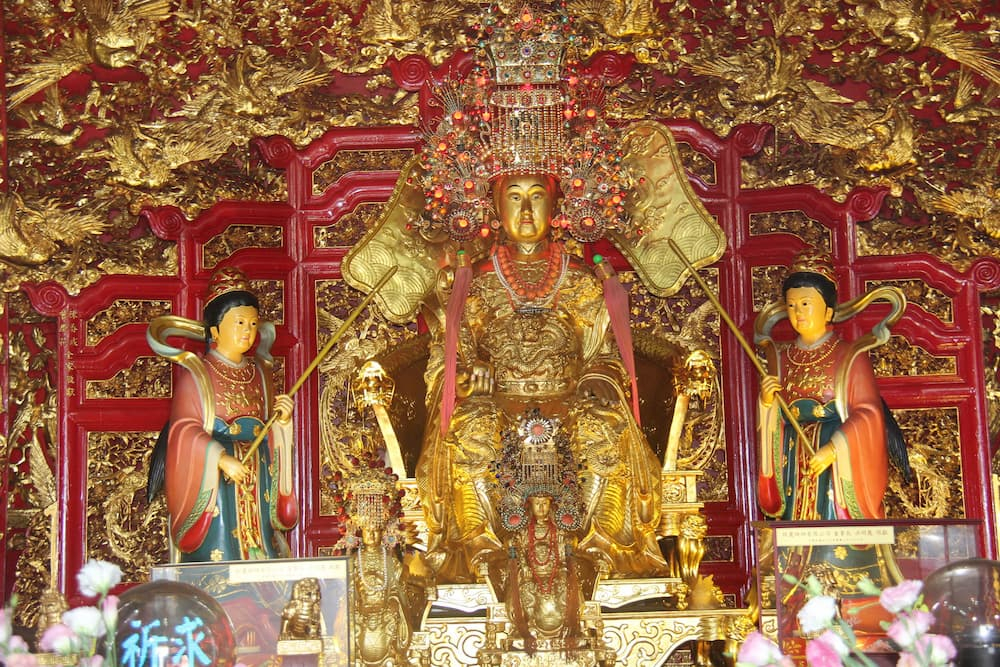
Veneration of Tianhou (Mazu)
Splendid
Chi Culture
Topic
Veneration of Tianhou (Mazu)
Tianhou (literally “celestial empress”), personal name Lin Mo, is also known variously as “Tongxian shennü” (Worthy and efficacious divine woman), “Tianhou shengmu” (Celestial empress—the divine mother), “Mazu” (Maternal ancestor), “Niangma” (Mother), and a nunmber of others. People addressed her with different titles depending on the historical period, locale, and their own social status. The belief in Mazu and the associated customs were inscribed in 2009 by the United Nations Educational, Scientific, and Cultural Organization on the Representative List of the Intangible Cultural Heritage of Humanity.
The social status of Tianhou, a goddess worshipped by the general populace, has grown gradually over time. At first, she was known among the people as the sea goddess. In 1122, Supervising Secretary Lu Yundi (nd) sailed to Koryo (Korea) on a diplomatic mission. Windstorms destroyed all the ships except his. He reported to Emperor Huizong (r. 1100–1125) that the reason his ship survived was that it had been rescued by the sea goddess. The following year, the emperor bestowed a plaque, inscribed “Smooth Rescue,” upon the goddess temple in Meizhou, Fujian. Since then, the divine woman Lin Mo has been commended and honorary titles have been conferred on her thirty times. From “Lady,” and “Celestial Consort” to the most revered “Celestial Empress—the Divine Mother.” She and her rites were also included on the list of state religious rites.
Legendary stories about Tianhou circulating in modern times come from several major sources, including historical documents, oral tradition, and painting scrolls depicting her divine deeds. As the Tianhou worship grew, stories of various versions have formed and been collected. Tianhou has been worshipped for more than one thousand years and in a variety of places, so there are many regional traditions and tales. Regardless of the type of story, they are all about supernatural powers, and they embody the people’s good wishes and imagination. Most of the stories feature the assuaging of sufferings, the averting of calamities, the warding off of evils, and the guiding of people to perform good deeds—such stories circulated freely and survived among the populace over a long time. The imperial court often publicized her story and divine power in order to maintain its rule.
There is not much difference in terms of worshiping Tianhou and other Chinese deities—temples need to be built, statues erected, sacrificial vessels arranged, offerings provided, and sacrifices performed regularly. The imperial court sent officials to offer sacrifices to Tianhou many times since the Song dynasty (960–1279). During the Qing dynasty (1644–1911), the court stipulated that local officials had to make sacrificial offerings in the spring (second month in the lunar calendar) and the autumn (eighth month in the lunar calendar); furthermore, all the ceremonies were to be recorded. Offerings and rituals were strictly regulated. However, there were no strict rules regarding offerings and sacrifices made by the common people. Aside from Tianhou’s birthday (23rd of the third month in the lunar calendar) and other festivals, devout believers would worship her at any time. The “three sacrifices” (pig, sheep, and ox), poultry, melons, fruits, and vegetables were offered during the ceremony. The rites generally follow local customs and practices. Because polytheism was popular among the people in China, it was common to worship Tianhou as well as other deities at the same time. Large-scale religious activities were often accompanied by community activities such as parades, temple fairs, and magic shows.
It has been over eight hundred years since the Chinese began venerating Tianhou as a popular deity. If one goes further back and counts from the birthday of Lin Mo, an ordinary girl, it is over one thousand years. Lin Mo has gone from being a local deity revered by the people of Meizhou Island, Fujian province, to a goddess worshipped by believers throughout several other provinces in the country, as well as vast numbers in the Chinese diaspora (Southeast Asia, the Americas, Australia, and Europe). Tianhou is widely worshipped throughout the world. Even today, there are still a considerable number of believers. To a certain degree, she has become the Goddess of Peace who connects the Chinese at home and overseas, including the Chinese on either side of the Taiwan Straits.
Veneration of Tianhou has lasted over a thousand years and become a cultural phenomenon. It is an integral part of Chinese religious culture, but undoubtedly, it also contains elements of religious superstition and personal desires. Nevertheless, it has had a close relationship with imperial power in ancient China, the maritime industry, local customs, and folk arts. The study of Tianhou worship is complex and resists simplification.



